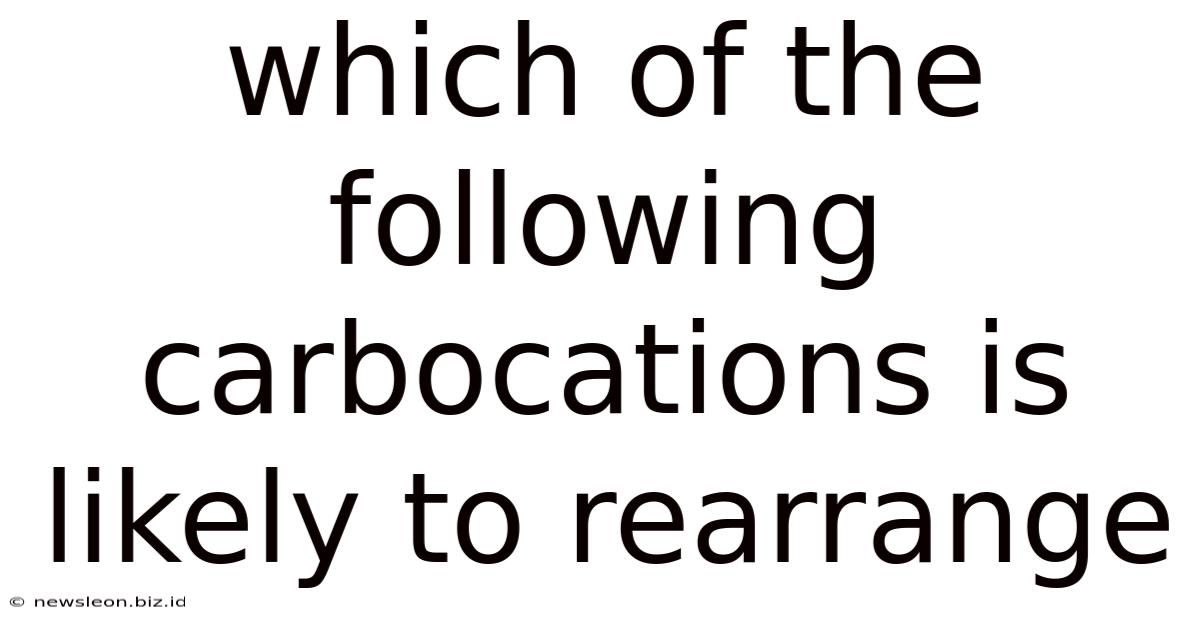Which Of The Following Carbocations Is Likely To Rearrange
News Leon
May 05, 2025 · 5 min read

Table of Contents
Which of the Following Carbocations is Likely to Rearrange? A Deep Dive into Carbocation Stability and Rearrangements
Carbocations, positively charged carbon atoms, are fascinating and crucial intermediates in many organic reactions. Their inherent instability drives them to undergo rearrangements to achieve greater stability. Predicting which carbocations will rearrange and which will not is a key skill in organic chemistry. This article will delve into the factors governing carbocation stability and explore how to predict carbocation rearrangements. We'll analyze various examples to solidify understanding.
Understanding Carbocation Stability
The driving force behind carbocation rearrangements is the quest for greater stability. Carbocation stability is primarily determined by three factors:
1. Hyperconjugation
Hyperconjugation is a stabilizing interaction between the empty p-orbital of the carbocation and the sigma (σ) bonds of adjacent alkyl groups. The more alkyl groups attached to the positively charged carbon, the greater the degree of hyperconjugation and thus, the greater the stability. This explains the stability order:
- Tertiary (3°) carbocation > Secondary (2°) carbocation > Primary (1°) carbocation > Methyl carbocation
The tertiary carbocation boasts three alkyl groups donating electron density through hyperconjugation, making it the most stable. The methyl carbocation, lacking any alkyl groups, is the least stable.
2. Inductive Effect
Alkyl groups are electron-donating through the inductive effect. This means they push electron density towards the positively charged carbon, partially neutralizing the positive charge and stabilizing the carbocation. The more alkyl groups, the stronger the inductive effect and the greater the stabilization. This effect reinforces the stability order established by hyperconjugation.
3. Resonance
Resonance stabilization occurs when the carbocation can delocalize its positive charge across multiple atoms through pi (π) bonds. This significantly increases stability. Allylic and benzylic carbocations are prime examples, benefiting greatly from resonance stabilization.
Predicting Carbocation Rearrangements: The Rules of the Game
Carbocations will readily rearrange if the rearrangement leads to a more stable carbocation. These rearrangements typically involve the migration of a hydride (H-) or an alkyl group (e.g., methyl, ethyl) to the positively charged carbon. The migrating group shifts with its bonding electrons, forming a new bond with the carbocationic carbon.
Here’s a breakdown of the process:
-
Identify the carbocation: Begin by identifying the initial carbocation formed in a reaction.
-
Assess stability: Determine the stability of the initial carbocation based on the factors discussed above (hyperconjugation, inductive effect, resonance).
-
Look for rearrangement possibilities: Examine the neighboring carbons for the possibility of hydride or alkyl shifts.
-
Evaluate the resulting carbocation: After a potential rearrangement, assess the stability of the newly formed carbocation. If the rearranged carbocation is more stable than the initial one, the rearrangement is likely to occur.
-
Consider the 1,2-shift: Rearrangements typically involve a 1,2-shift, meaning the migrating group moves from one carbon to an adjacent carbon.
Examples of Carbocation Rearrangements
Let's illustrate these principles with examples:
Example 1: Rearrangement of a secondary carbocation to a tertiary carbocation
Consider the reaction involving the solvolysis of 3-methyl-2-pentanol. The initial carbocation formed is a secondary carbocation. However, a 1,2-hydride shift can lead to a more stable tertiary carbocation:
[Insert diagram showing the secondary carbocation rearranging via a 1,2-hydride shift to a tertiary carbocation. Clearly label the migrating hydride and the resulting tertiary carbocation.]
The tertiary carbocation is significantly more stable due to increased hyperconjugation and inductive effects. This rearrangement is therefore highly favored.
Example 2: Rearrangement involving a phenyl group
Benzylic carbocations are exceptionally stable due to resonance stabilization. Consider a reaction where a carbocation is initially formed on a carbon adjacent to a phenyl ring. A 1,2-hydride shift can result in a benzylic carbocation, which is highly favored:
[Insert diagram showing the initial carbocation rearranging via a 1,2-hydride shift to a benzylic carbocation. Clearly label the migrating hydride and the resulting benzylic carbocation, highlighting the resonance structures.]
The resonance stabilization of the benzylic carbocation dramatically increases its stability, making the rearrangement very likely.
Example 3: A case where rearrangement is less favorable
Not all carbocations rearrange. Consider a tertiary carbocation. Since it's already quite stable, a rearrangement is less likely unless it leads to an exceptionally stable carbocation, such as one with significant resonance stabilization. A rearrangement would likely require a considerable energetic input, making it less probable.
Example 4: Competitive Rearrangements
In some cases, multiple rearrangements are possible. The rearrangement leading to the most stable carbocation will be favored. Consider a scenario with two possible hydride shifts, one leading to a secondary and the other to a tertiary carbocation. The tertiary carbocation pathway will overwhelmingly dominate.
Factors Affecting the Rate of Rearrangement
While the stability of the resulting carbocation is the primary driving force, other factors influence the rate of rearrangement:
-
Temperature: Higher temperatures generally accelerate rearrangements.
-
Solvent: The solvent can affect carbocation stability and hence the likelihood of rearrangement.
-
Steric hindrance: Bulky groups can hinder the migration of groups and slow down the rearrangement.
Conclusion: Predicting the Unpredictable (Almost)
While predicting carbocation rearrangements isn't an exact science, understanding the fundamental principles of carbocation stability, the rules governing rearrangements, and the influencing factors provides a strong foundation for accurate predictions. By systematically evaluating the stability of the initial and potential rearranged carbocations, one can confidently predict the likelihood of rearrangement in many organic reactions. Remembering the drive towards increased stability through hyperconjugation, inductive effects, and resonance is key to mastering this crucial aspect of organic chemistry. Practicing with various examples will further solidify your understanding and improve your predictive capabilities.
Latest Posts
Related Post
Thank you for visiting our website which covers about Which Of The Following Carbocations Is Likely To Rearrange . We hope the information provided has been useful to you. Feel free to contact us if you have any questions or need further assistance. See you next time and don't miss to bookmark.